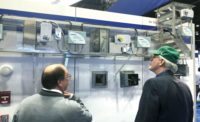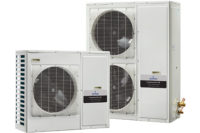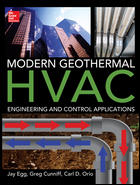As familiar as condensing units are in refrigeration systems, these components are undergoing major changes. Several of those changes are being demonstrated in a number of practical applications nationwide.
High-Ambient Temps
Woodland, Calif., is one of the hottest climates in the U.S. with ambient temperatures often reaching 110˚F and roof temperatures exceeding 120˚. Under those extreme conditions, properly refrigerating food products can be a daunting challenge.
The outside condenser is a key component of supermarket refrigeration systems. When hot refrigerant is sent through the condenser coils, the heat that has been extracted from the refrigerated cases and added by the compressor is dissipated to the outside air. That is key to the entire refrigeration process.
Historically, there have been two primary types of condensers. The air-cooled condenser dissipates heat by blowing outdoor air across the condenser coils. However, under high-ambient conditions, like in Woodland, air-cooled condensers may lack sufficient ability to dissipate the heat, so cooling capacity falls.
A second type, the evaporative condenser, improves performance by spraying water across the condenser coils and reducing energy consumption. At the same time, these condensers consume water, which may be scarce in some areas.
Baltimore Aircoil Co.’s (BAC) TrilliumSeries condenser was developed to provide the best of both worlds, according to officials at the company. The condenser uses a patented dry-coil adiabatic design that saves energy, reduces refrigerant charge, and lowers operating costs, the company said. The on-demand adiabatic pre-cooler uses water only on the hottest days to maintain condensing temperatures.
When the ambient air is below the set point, such as 80˚ in Woodland, the condenser runs as a dry cooler to save water and energy. The ambient air condenses the refrigerant in the microchannel coils, which is then returned to the system.
When the ambient temperature is above the set point, the unit will run in the pre-cooler mode. Water is evenly sprayed over the pre-cooler media. As the air passes through the media, water is evaporated into the air, and the air is humidified, cooling temperatures down to 2-3˚ above wet-bulb temperature. Such substantial depression of the dry-bulb temperature results in a major increase in cooling capacity.
In the summer of 2012, Jeff Albright, vice president, Nugget Markets, was faced with replacing an evaporative condenser. Because of the high-ambient temperatures, he once again considered evaporative condensers. He was concerned that the water in Woodland is hard and makes water treatment difficult. He decided to go with a Trillium Series condenser, so as to use less water and be less impacted by hard water.
With BAC representatives on site, Sam Wilson, owner, Refrigeration Solutions Inc., West Sacramento, Calif., coordinated and performed the installation and start up work. As part of the project, he also converted the refrigerant from HCFC-22 to HFC-407F.
The approach will be used in other Nugget store locations.
Low-Pressure Control
A foodservice operation in Ontario, Canada, was looking for a way to better maintain low-pressure control on condensing units and so it turned to an Electronic Unit Controller (EUC). The unit chosen was manufactured by Emerson Climate Technologies.
Ben Kungl, president, Oxford Energy Solutions of Woodstock, Ontario, Canada, said, “It is simple, trustworthy, and easy to use. It has money- and time-saving benefits for both the customer and contractor, while offering superior condensing-unit protection.”
The EUC can be used instead of a traditional mechanical low-pressure control switch on Copeland condensing units with an electronic controller and transducer. The EUC is said to be able to be set in less than one minute and maintain low-pressure control accurately. The accuracy and troubleshooting diagnostics aspect were designed to reduce callbacks and service repair time.
Applications for the controller include commercial refrigeration systems, particularly for walk-in coolers and freezers. It is targeted for small- to medium-sized foodservice operations.
This new generation of systems is designed to offer contractors better control functions, diagnostics, and system protection, along with time savings, in a compact and ready-to-install condensing unit package, advocates said. They said the EUC allows a single condensing unit to operate on multiple refrigerants. This was designed to allow improved inventory levels for wholesalers and better product availability for contractors.
According to the manufacturer, the EUC provides refrigeration system shutdown protection to prevent compressor failure and related repairs, and diagnostic troubleshooting to help prevent routine problems from becoming unexpected capital expenses.
Condensing New Refrigerants
New developments in condensers are also affecting new refrigerants. For example, a Hy-Vee supermarket in Fairfield, Iowa, used Hillphoenix’s Second Nature Low Temperature CO2 secondary system for its cases and walk-in freezers. The low-temperature system uses CO2 fluid as a secondary coolant in a loop piping system. With this technology, CO2 is super-cooled into liquid form and then travels throughout the low-temperature food cases and walk-ins, where it absorbs heat, which is then removed through condenser evaporators in the machine room. Then, the CO2 is supercooled again and sent back through the cases in a continuing loop.
The Second Nature Low Temperature CO2 secondary system also offered Hy-Vee a simpler system to maintain and operate. Explained John Gallaher, director of business development for Hillphoenix, “With CO2 as the secondary coolant, we’re able to remove expansion valves from the display cases and replace them with solenoid valves. This allows for a much simpler setup and operation of the system.”
Marc Sandofsky, a published author and practicing engineer with more than 30 years of experience, contributed to this article. Sandofsky has been awarded four U.S. patents on cooling-related energy-conservation technologies.
Publication date: 6/10/2013
Want more HVAC industry news and information? Join The NEWS on Facebook, Twitter, and LinkedIn today!










